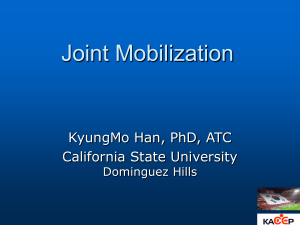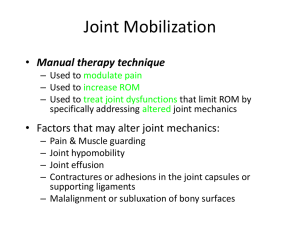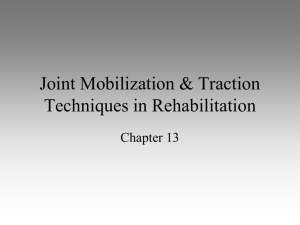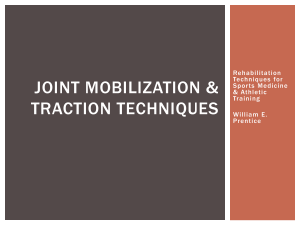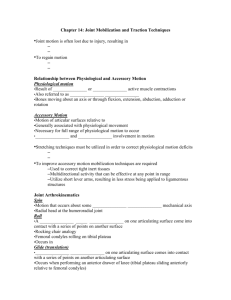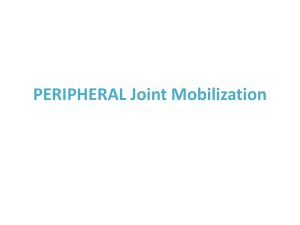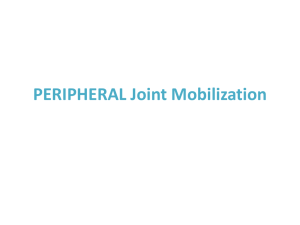Manual Therapy Techniques
advertisement
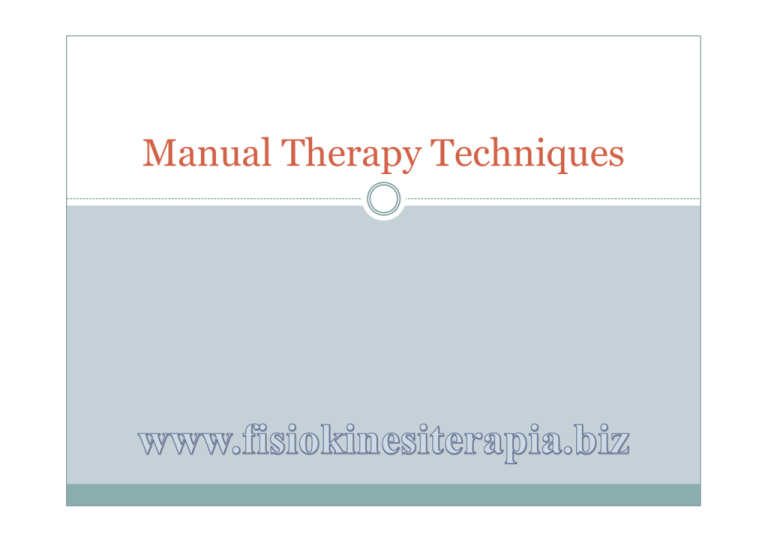
Manual Therapy Techniques
Sports massage:
y
Systematic manipulation
of soft tissue
{
{
{
y
Stimulates relaxation and
blood vessel dilation
Reduces edema and improve
tissue mobility
No conclusive evidence of
effectiveness
Hoffa massage:
traditional strokes
{
{
Effleurage, petrissage,
percussion/tapotement,
vibration
Friction massage: increase
inflammatory response
y Acupressure: massage
of trigger points
y Indications:
y Contraindications
y Precautions
y Application
Myofascial release
y
Fascia is found around muscles and other tissues
{
{
{
y
Superficial layer: skin undersurface; where edema accumulates
Deep layer: around muscle, tendon, joints, ligaments, bone
Subserous fascia: around internal organs (not treated)
Techniques:
{
{
{
{
Trigger point examination
Trigger point ice treatment
Trigger point ischemic compression
Trigger point stripping/Rolfing
y Application:
{ daily sessions; 3-5 min.
{ Each stroke lasts about 90sec.
Mobilization and Traction:
y Slow, passive movements
of articulating surfaces
y Used to:
{
{
{
{
Regain AROM & PROM
Realign a joint
Regain normal force
distributions
Reduce pain
Physiologic vs. Accessory Motion
y Physiologic:
{
{
{
{
Osteokinematic
Results from muscle
contractions that move
joints
Occurs in cardinal planes
Measured in degrees
y Accessory:
{
{
{
{
{
{
{
{
Manner in which
articulating surfaces move
in relation to one another
Accompanies physiologic
motion
Measured in mm
Roll
Slide/glide
Spin
Compression
distraction
Accessory Motion:
y
Spin: occurs around
stationary axis
{
Radial head during
pronation/supination
y Roll: series of points on one
surface contacts another
series of points
{
Femoral condyles rolling
over tibial plateau
y
Glide: translation; one
point comes in contact
with a series of points
{
{
{
Anterior drawer
Pure gliding occurs in
surfaces are congruent
Use concave-convex rule
Concave-Convex Rule:
y
If the concave joint surface is moving on a stationary
convex surface, gliding will occur in the same
direction as the rolling motion
{
{
y
If the convex segment moves, the treatment plane is fixed
Glide in the direction opposite the restriction
If the convex surface is moving on a stationary
concave surface, gliding will occur in an opposite
direction to rolling
{
{
If the concave segment moves, the treatment plane moves
with it
Glide in the same direction as the restriction
Joint Positions:
y Resting position:
{ Joint capsule and
ligaments are most
relaxed
{ Maximum jt. Play
{ Testing position
y Loose-packed:
{ Articulating surfaces are
maximally separated
{ Mobilization and traction
done here
y Close-packed:
{ Maximum contact
{ No jt. Play
{ Capsule & ligaments tight
y Improves fluid flow and
reduces muscle spasm
Treatment Techniques:
y Treat hypomobile joints with mobilization and
traction
y Treat hypermobile joints with strengthening,
stability exercises, and taping/bracing
y Treatment plane falls ⊥ to axis of rotation in
convex surface to center or concave surface
y Use translational movement:
Mobilization = parallel to tx plane
{ Traction = perpendicular to tx plane
{
Mobilization Grades:
I
Small amp;
Pain and
beginning of ROM spasm
II
Large amp;
midrange ROM
Pain and
spasm
III
Large amp; up to
point of limitation
Pain and
tissue
tension
IV
Small amp; at
very end of ROM
No pain;
tightness
only
V
Small amp; quick
thrust at very end
ROM
**ManipuLation**
y Mobilization: used to
break adhesions and
stretch
{
{
Use 3-6 sets of oscillations
lasting between 20-60
seconds (1-3 oscillations
per second)
Treat pain first (everyday
ok), then stiffness (34x/week)
Joint Traction:
Traction: pull one
segment to separate
surfaces
y Use 10 second
intermittent grades I and
II, then distract to grade
III and release
y Should be used in
conjunction with
mobilization
y
I
Loosen
Neutralizes
without
separation
II
Tighten
(take up
the slack)
Separates
surfaces and
eliminates
play in
capsule
III
stretch
Stretching
on soft
tissue
Contraindications:
y
y
y
y
y
y
y
Inflammatory arthritis
Malignancy
Bone disease
Neurological involvement
Bone fracture
Congenital bone
deformities
Vascular disorders of
vertebral artery
